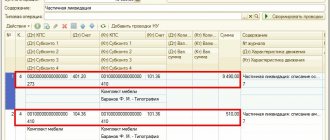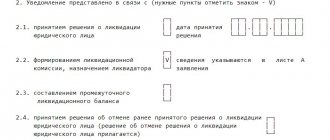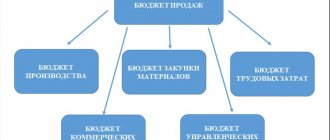"1C: Accounting 8": how to create a liquidation balance sheet
It guarantees the interests of creditors and serves as security for the statutory activities of the Company.
LLC is an institution where the authorized capital of the LLC is divided into shares. As evidenced by the Federal Law “On Limited Liability Companies” dated 02/08/1998 N 14-FZ (Article 2. Clause 1). It is possible to establish an LLC with one participant, the Law allows.
Let's look at the procedure for creating an LLC using an example. In practice, the formation of authorized capital occurs as follows:
- a meeting of two founders makes a decision to open a Company with an authorized capital of LLC 10 thousand rubles;
- The authorized capital, by decision of the meeting of founders, is formed in equal shares - 5 thousand rubles each. from each founder;
- Each founder opens a savings account in a bank with an asset of 5 thousand rubles. Bank orders for a total amount of 10 thousand rubles. confirm this fact;
- documents are submitted for LLC registration;
- After the official registration of the LLC, a current account is opened in the same bank. Funds are transferred from savings accounts. Confirmation documents – bank statements.
Closing an account upon liquidation of an organization: general information
The procedure for terminating a bank account agreement is regulated by:
- Art. 859 Civil Code of the Russian Federation;
- Instruction of the Central Bank of the Russian Federation “On opening and closing...” dated May 30, 2014 No. 153 (hereinafter referred to as Instruction 153-I).
It is also important to consider the following provisions:
- Law “On Societies...” dated 02/08/1998 No. 14-FZ;
- Law “On State Registration...” dated 08.08.2001 No. 129-FZ.
The legislator does not establish a specific period within which the account must be closed. However, it should be taken into account that the credit institution has the right to terminate the agreement on its own initiative. This is possible if:
- There are no funds in the account.
- There are no transactions for 2 years. This provision is regulated by clause 1.1 of Art. 859 of the Civil Code of the Russian Federation. According to it, the bank is obliged to send the client a notice of its decision no later than 2 months before closing the account.
Closing a current account during the liquidation of an LLC, as a rule, occurs after the complete cessation of the company's activities. However, the law does not prohibit doing this earlier, for example, after approval of the interim liquidation balance sheet. If at the time of closing the account there were funds on it, the bank returns them in full within 7 days (clause 8.3 of Chapter 8 of Instruction 153-I). If you do not collect them during this period, the money will be transferred by the bank to its special account.
If an organization has several current accounts, provided that one remains active, each of them can be closed at any time, including during the liquidation process.
The specifics of the procedure for closing a current account depend on the order in which the company is liquidated - forced or voluntary.
Postings on authorized capital when creating an LLC
If the newly created LLC will keep accounting records in full, then the following entries will be generated (as of the date of state registration):
- Based on an accounting certificate (as a primary document)
D 75.01 - By 80.01 the amount is 10 thousand rubles. – formation of authorized capital;
- Based on two bank statements (for each founder)
D 51 - K 75.01 amount 5 thousand rubles. founder 1;
https://www.youtube.com/watch?v=ytadvertiseru
D 51 - K 75.01 amount 5 thousand rubles. founder 2.
If a newly created LLC applies the simplified tax system, then it is exempt from the obligation to maintain accounting records.
When calculating income tax when determining the tax base, expenses for contributions to the authorized capital are not taken into account (Article 270, paragraph 3 of the Tax Code of the Russian Federation).
On accounting for expenses during liquidation of production
| Experts from the GARANT Legal Consulting Service Tatyana Sinelnikova and Sergey Rodyushkin talk about accounting for costs associated with stopping and closing production, as well as the procedure for disposing of fixed assets in this situation. |
| Income tax According to paragraph 1 of Art. 252 of the Tax Code of the Russian Federation, for the purposes of Chapter 25 of the Tax Code of the Russian Federation, the taxpayer reduces the income received by the amount of expenses incurred (except for the expenses specified in Article 270 of the Tax Code of the Russian Federation). Expenses are recognized as justified and documented expenses incurred (incurred) by the taxpayer. Justified expenses mean economically justified expenses, the assessment of which is expressed in monetary form. Documented expenses mean expenses supported by documents drawn up in accordance with the legislation of the Russian Federation. In accordance with paragraphs. 8 clause 1 art. 265 of the Tax Code of the Russian Federation, non-operating expenses taken into account when calculating income tax include expenses for the liquidation of fixed assets being decommissioned, including amounts of depreciation underaccrued in accordance with the established useful life, as well as expenses for the liquidation of unfinished construction projects and other property, installation which has not been completed (costs of dismantling, dismantling, removal of disassembled property), protection of subsoil and other similar work. The date of non-operating expenses is the date of presentation to the organization of documents serving as the basis for making calculations, or the last date of the reporting (tax) period (clause 3, clause 7, article 272 of the Tax Code of the Russian Federation). Thus, when writing off (liquidating) not fully depreciated property in the tax accounting of the taxpayer, it is not losses that are formed, but non-operating expenses, which are taken into account when determining the tax base for income tax at a time on the date of signing by the liquidation commission of the act on the performance of work to liquidate the fixed asset (letter Ministry of Finance of Russia dated September 11, 2009 No. 03-05-05-01/55; see also the resolution of the Federal Antimonopoly Service of the West Siberian District dated February 26, 2010 No. A27-6662/2009). Thus, costs when writing off equipment can be taken into account as part of non-operating expenses. Moreover, if liquidation work lasts more than one month, during this period the taxpayer must continue to charge depreciation on the liquidated property based on its full cost (clause 4 of Article 259 of the Tax Code of the Russian Federation). Let us note that the Russian Ministry of Finance admits that during the period of absence of production (downtime), the taxpayer’s expenses attributable to direct expenses (salaries of employees, depreciation of equipment not transferred to mothballing) can be taken into account as part of non-operating expenses (see letter from the Ministry of Finance of Russia dated 04.04 .2011 No. 03-03-06/1/206). It should also be borne in mind that the cost of materials or other property received during the dismantling of fixed assets is included in the organization’s non-operating income on the basis of clause 13 of Art. 250 Tax Code of the Russian Federation. Thus, we believe that costs associated with stopping and closing production (including wages of employees, depreciation, utilities) and actually incurred during the liquidation of equipment are included in non-operating expenses taken into account when calculating income tax. Accounting In the situation under consideration, due to the liquidation of production, fixed assets are disposed of. The procedure for disposal of fixed assets is regulated by PBU 6/01 “Accounting for fixed assets” (hereinafter referred to as PBU 6/01). According to clause 29 of PBU 6/01, an object of fixed assets that is retired or is not capable of bringing economic benefits (income) to the organization in the future is subject to write-off from accounting. Expenses include the residual value of the fixed asset, as well as the costs of its dismantling, transportation, packaging, etc. Paragraph 4 of PBU 10/99 “Expenses of the organization” (hereinafter referred to as PBU 10/99) provides that the expenses of the organization, depending on their nature, conditions of implementation and areas of activity of the organization, are divided into expenses for ordinary activities and other expenses. In accordance with paragraph 5 of PBU 10/99, as a general rule, expenses for ordinary activities are expenses associated with the manufacture and sale of products, the acquisition and sale of goods, as well as expenses the implementation of which is associated with the performance of work and the provision of services. In this case, expenses other than expenses for ordinary activities are considered other expenses (clause 4 of PBU 10/99). Since in the situation under consideration the products are no longer produced, expenses in the form of wages to personnel, depreciation deductions, utility bills, costs of liquidation of equipment, etc. are not associated with the manufacture and sale of products, the acquisition and sale of goods, as well as with the performance of work and the provision of services. Accordingly, they also do not form the cost of work in progress and are not taken into account in cost accounts. Therefore, by virtue of clause 11, 12 PBU 10/99 such expenses are taken into account as part of other expenses and are reflected in account 91, subaccount “Other expenses”. The texts of the documents mentioned in the experts’ response can be found in the GARANT legal reference system. |
Postings on the authorized capital during the liquidation of an LLC
In such a situation, interim and final liquidation balance sheets are drawn up. The interim balance sheet should show the status of mutual settlements with debtors and creditors; indicators of losses or profits; figures for the state of the authorized capital - account 80.1.
It should be borne in mind that when checking before the closure of an LLC or the liquidation of a CJSC, the tax office may impose fines, which should also be reflected in the interim liquidation balance sheet.
If an enterprise is liquidated with a profit, then the repayment of debts to creditors occurs at the expense of it. Otherwise, it is the authorized capital that is the source of debt repayment: K 80.1 – D 75.2 Mutual settlements with creditors.
If the enterprise is liquidated at a loss, then amounts are paid to the founders from the current account in proportion to contributions to the authorized capital of the LLC.
It is transactions of this type: K 80.1 – 51 (for each founder) that are indicated in the final liquidation balance sheet. Based on bank statements. After this, the company's current account is closed.
Postings upon liquidation
Hello Veronica
The property of the liquidated company remaining after completion of settlements with creditors is distributed by the liquidation commission among the participants in the following order. First of all, payments are made to the participants of the company of the undistributed part of the profit, that is, for dividends reflected in account 84 “Retained profit (uncovered loss)”. Secondly, the property of the liquidated company is distributed among the company's participants in proportion to their shares in the authorized capital of the organization. After completing settlements with creditors, the liquidation commission draws up a liquidation balance sheet, which is approved by the founders (participant) of the legal entity or the body that made the decision to liquidate the legal entity. This balance sheet must contain zero indicators, that is, it must contain dashes for all types of property and liabilities. If at the time of closure (before drawing up the liquidation balance sheet) of the organization it has unclaimed amounts of accounts payable and receivable for which the statute of limitations has expired, then they must be written off in the generally established manner with the inclusion of the corresponding amounts in non-operating income and expenses according to the accounting rules and tax accounting. After drawing up the liquidation balance sheet, the property that remains with the organization after all settlements with creditors is subject to distribution among its founders. But first you need to determine the total amount of capital that will be distributed. If, according to the liquidation balance sheet, the organization has a profit remaining, then this operation is reflected in the following entry: Debit 99 Credit 84, subaccount “Retained earnings of the reporting year” - the profit of the reporting year is reflected; Debit 84, subaccount “Retained earnings of the reporting year”, Credit 80 – the organization’s profit is credited to the authorized capital. If, according to the liquidation balance sheet, the organization has a loss, then it must be repaid at the expense of the authorized capital, while the undistributed loss of previous years is transferred to the losses of the reporting year. Reflection of transactions in accounting: Debit 84, subaccount “Undistributed loss of the reporting year”, Credit 84, subaccount “Uncovered loss of previous years” - the uncovered loss of previous years is transferred to the loss of the reporting year; Debit 80 Credit 84, subaccount “Uncovered loss of the reporting year” - the authorized capital is reduced by the uncovered loss of the reporting year. Thus, the real amount of the authorized capital is determined, which will be distributed among the founders of the organization. The accrual of amounts that are payable to the founders of a legal entity is reflected in the following entry: Debit 80 Credit 75 – reflects the amount of the authorized capital of the organization to be distributed among the founders (participants). The distribution of property between the founders is made on the basis of an act, which must indicate to whom and what was transferred. The act must be signed by all participants of the organization, the payment of shares to the participants of the organization is recorded in the accounting records with the corresponding entry: Debit 75 Credit 50, 51 – their share of the authorized capital was paid to the participants.
The liquidation balance must be zero or not
Sooner or later in the life of every accountant there comes a time when he has to draw up an interim liquidation balance sheet. How does it differ from regular, annual or liquidation, and this article is written.
Every enterprise goes through three mandatory stages in its life cycle:
- - registration;
- — functioning, making a profit;
- - liquidation.
The first two stages of existence require the organizers and participants to be extremely focused and accurately prepare documents. The process of LLC liquidation is no less important.








